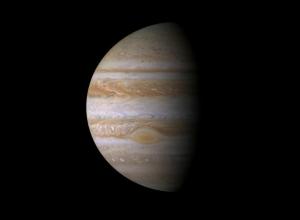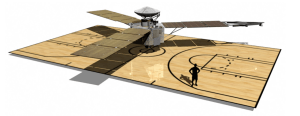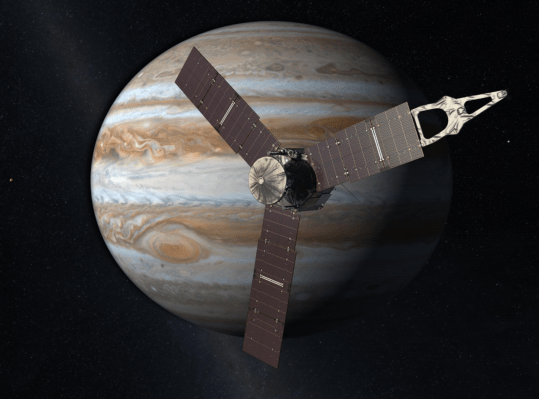After traveling five years through the solar system, Juno has finally reached its destination and is currently in orbit around Jupiter, traveling nearly 250,000 kilometers per hour (150,000 mph).
The most dangerous aspect of the $1.13 billion mission, which launched in 2011, occurred this evening at 11:18 pm ET when Juno initiated its final approach procedures. In order to successfully insert itself into orbit around Jupiter (instead of flying right past the planet, or crashing into it), Juno needed to ignite its main engine for 35 minutes.
Now that Juno has successfully completed this burn, it will begin its first of 37 orbits around Jupiter.

Jupiter imaged by the Cassini spacecraft / Image courtesy of NASA
During these orbits, Juno will repeatedly dive through Jupiter’s radiation belts, coming within 3,000 miles of Jupiter’s cloud tops at its closest approach. With a suite of scientific instruments, Juno will provide data to improve our understanding of Jupiter’s formation and evolution.
“Juno’s study of Jupiter will help us to understand the history of our own solar system and provide new insight into how planetary systems form and develop in our galaxy and beyond.” – NASA Jet Propulsion Laboratory
Juno, which was named after the Roman goddess who was Jupiter’s wife, will enable scientists to see below Jupiter’s dense cloud cover – something that’s never been done before.
One of the reasons this is such a unique mission is because its destination is extremely dangerous. Of the eight known planets in the solar system, Jupiter has the largest magnetic field and the highest radiation. Because of this, Juno had to be specially designed to survive these extremes long enough to retrieve useful data from this mysterious planet.
To put the extremes of Jupiter in perspective, the background radiation that we’re exposed to here on Earth is about 0.39 RAD. On Jupiter, Juno is expected to see 20,000,000 RAD over the course of its lifetime.
In NASA’s trailer for the Juno mission, scientists describe Jupiter as an unforgiving, relentless monster.
“It’s spinning around so fast that its gravity is like a giant slingshot slinging rocks and dust, electrons and whole comets. Anything that gets close to it becomes its weapon.” – NASA Juno Science Team

Juno spacecraft size in relation to a basketball court / Image courtesy of NASA/JPL
NASA’s needed a spacecraft strong enough to withstand this environment and their answer was Juno: a nearly 8,000 pound spacecraft with three different solar panels that stretch out to 9 meters in length.
At the beginning of the Jupiter orbit insertion, Juno carried 1,232 kilograms of fuel. Now that the 35-minute insertion burn has been completed, there’s only 447 kilograms of fuel left on the spacecraft. Juno will use the remaining fuel to complete the next 36 orbits around Jupiter and ultimately de-orbit into the planet itself.
The video above shows a peek of what the spacecraft saw as it neared its final approach. Captured with the JunoCam camera on June 29th, Jupiter along with four of its moons (Callisto, Ganymede, Europa, and Io) can be seen. All equipment on board, including the science instruments and JunoCam, were turned off on June 30th to prepare the spacecraft for the most dangerous part of its mission: the Jupiter orbit insertion.
“The scariest thing to me about Juno are the unknowns. So much about the environment that it will have to withstand is unknown. Nothings really certain about what’s going to happen.” – NASA Juno Science Team
There’s still a long, dangerous road ahead for Juno, but if everything else goes as planned, the mission will end with the spacecraft de-orbiting and crashing into Jupiter in 2018.
